Iran is likely engaging in a coordinated information effort to deter an Israeli strike targeting its nuclear facilities and reassure its domestic population about Iran’s ability to protect such facilities. The Islamic Revolutionary Guards Corps (IRGC) Nuclear Security and Protection Corps Commander Brigadier General Ahmad Haghtalab announced on April 18 that Iran will change its publicly stated “nuclear doctrine and policies” in the event of an Israeli strike targeting its nuclear facilities.[i] Haghtalab also said that the Iranian National Passive Defense Organization—one of the regime bodies responsible for defending its civilian, military, and nuclear infrastructure from attacks—has plans in place to face “any threat from” Israel.[ii] The International Atomic Energy Agency (IAEA) evacuated its inspectors from Iranian nuclear facilities on April 16. The IAEA cited concerns that Israel might strike Iranian nuclear facilities in response to Iran’s April 13 drone and missile strikes targeting Israel.[iii]
Most of Iran’s official state media apparatus, including media outlets controlled by the Supreme National Security Council (SNSC)—the main regime body overseeing Iranian nuclear policy—highlighted Haghtalab’s announcement.[iv] This reporting suggests that officials at the highest levels of the Iranian government endorsed the announcement, including the SNSC and the Office of the Supreme Leader. Western officials and analysts have often expressed concern that a US or Israeli strike targeting Iran’s nuclear facilities would spur Iran to renew its nuclear weapons program.[v] Iran is likely seeking to exploit this long-standing concern to influence Israeli calculations. Iran is also likely seeking to exploit this concern to influence Western governments to place pressure on Israel not to strike Iran’s nuclear program. The Iranian regime has also long touted its nuclear program as a significant national achievement and probably seeks to reassure its population that it will protect its nuclear accomplishments.[vi]
Iran’s attempt to deter an Israeli retaliatory strike does not mean that Iran will not pursue nuclear weapons development, however. Iranian officials have long said that Iran will not weaponize its nuclear program, citing Supreme Leader Ali Khamenei’s 2003 fatwa outlawing nuclear weapons.[vii] Haghtalab’s announcement contradicts Khamenei’s stated opposition to nuclear weapons development and marks a notable departure from previous regime rhetoric with respect to its nuclear policies. CTP-ISW previously assessed in December 2023 that Iran has pursued a series of nuclear advancements consistent with the desire for a nuclear arsenal.[viii] The announcement also coincides with several senior Iranian officials, including IRGC Commander Major General Hossein Salami, expressing that the recent escalation cycle between Iran and Israel has significantly altered Iran’s external security calculus in an unspecified manner.[ix]
Houthi leader Abdulmalik al Houthi claimed on April 18 that the Houthi attacks on commercial shipping have extended “from the Red Sea to the Indian Ocean.”[x] The Houthis claimed on April 7 that they conducted two attacks targeting two commercial ships in the Indian Ocean and the Arabian Sea.[xi] CTP-ISW cannot confirm that these attacks occurred and did not observe any reporting that corroborated the Houthi claims. The Houthis have said on multiple occasions that its maritime attack campaign aims to blockade Israel to support the Palestinian people.[xii] The Houthis have expressed an aspiration to expand their attacks targeting Israeli shipping in the Indian Ocean and around the Cape of Good Hope.[xiii] The Houthis do not yet have this capability, but such a capability would allow the Houthis to attack alternate shipping routes that bypass the Red Sea. These attacks have forced major shipping companies to avoid the Red Sea and instead go around the Cape of Good Hope, which imposes additional time delays and costs on trade between Europe and Asia.[xiv] Houthi attacks have had limited success in “blockading” the Israeli port of Eilat on the Red Sea. Eilat’s revenue decreased by 80% between November 2023 and December 2023.[xv]
Key Takeaways:
- Iran: Iran is likely engaging in a coordinated information effort to deter an Israeli strike targeting its nuclear facilities and reassure its domestic population about Iran’s ability to protect such facilities.
- An unnamed senior US official told ABC News that Israel is unlikely to retaliate against Iran until after the Passover holiday.
- Yemen: Houthi leader Abdulmalik al Houthi claimed that the Houthi attacks on commercial shipping have extended “from the Red Sea to the Indian Ocean.”
- Northern Gaza Strip: The IDF Air Force struck Palestinian fighters and military infrastructure in the northern Gaza Strip.
- Central Gaza Strip: The IDF concluded a week-long operation targeting Palestinian fighters and military infrastructure near Nuseirat in the central Gaza Strip.
- Political Negotiations: Hamas Deputy Political Bureau head Musa Abu Marzouk said that Hamas will not withdraw from ceasefire negotiations or drop its maximalist demands, which include a permanent ceasefire in the Gaza Strip.
- West Bank: Israeli forces engaged Palestinian fighters in at least two locations in the West Bank.
- Southern Lebanon and Golan Heights: Lebanese Hezbollah conducted at least nine attacks from southern Lebanon into northern Israel.
- Iraq: The Iraqi government and private sector signed 14 memoranda of understanding (MOU), primarily in energy and finance, with US companies.
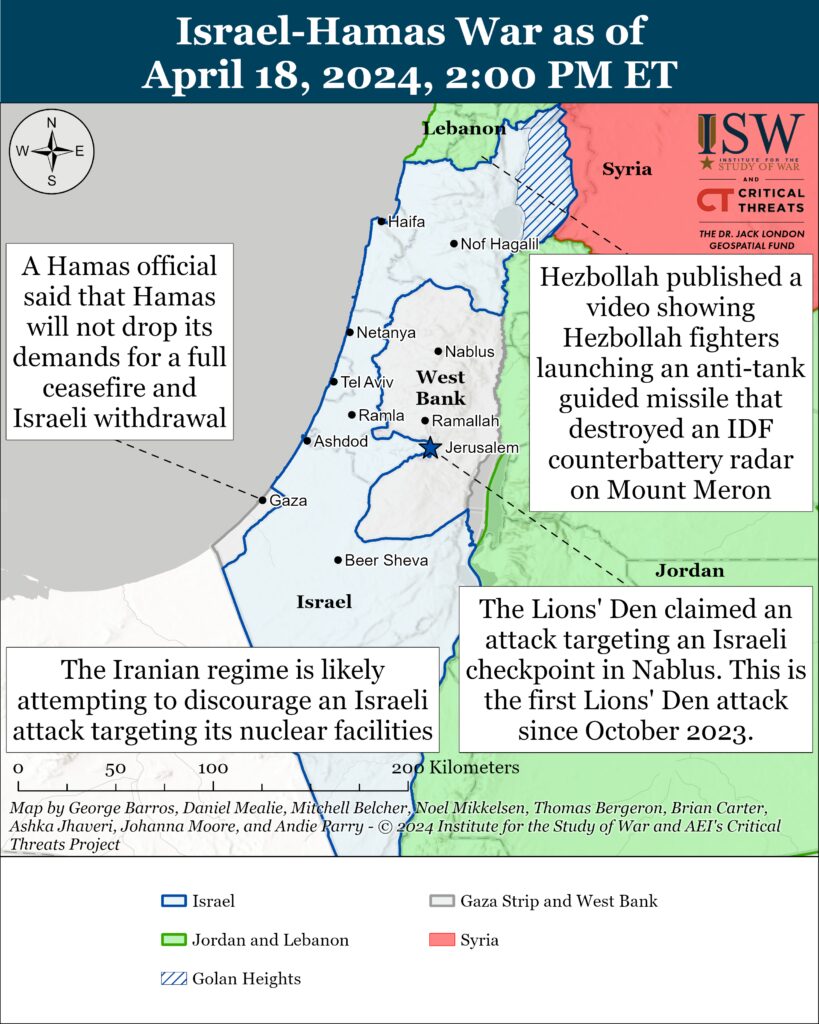
Gaza Strip
Axis of Resistance objectives:
Erode the will of the Israeli political establishment and public to sustain clearing operations in the Gaza Strip
Reestablish Hamas as the governing authority in the Gaza StripThe Israel Defense Forces (IDF) Air Force struck Palestinian fighters and military infrastructure in the northern Gaza Strip on April 18. The IDF Air Force struck a militia mortar position in Rimal neighborhood in western Gaza City that Palestinian fighters used to shell Israeli forces.[xvi] The IDF Air Force separately conducted an airstrike over the past week that killed a Hamas operative in the groups’ internal security apparatus in Beit Hanoun.[xvii] The Hamas-controlled Interior Ministry’s Internal Security Forces in the Gaza Strip employs fighters from the Hamas military wing.[xviii] CTP-ISW assessed on March 25 that a small number of Palestinian fighters have likely infiltrated Beit Hanoun.[xix] Israeli forces recently conducted raids targeting Hamas and Palestinian Islamic Jihad (PIJ) sites in Beit Hanoun.[xx]
Palestinian militias conducted several attacks targeting Israeli forces in the northern Gaza Strip on April 18. Hamas and the al Aqsa Martyrs’ Brigades, which is the self-proclaimed military wing of Fatah and aligned with Hamas in the war, conducted separate mortar attacks targeting Israeli forces near the Netzarim corridor in eastern Gaza City, where Israeli forces have constructed a highway to support military operations.[xxi] Hamas fighters detonated two explosively-rigged tunnels and mines targeting Israeli infantry and vehicles in Mughraqa in southern Gaza City.[xxii]
The National Resistance Brigades and al Aqsa Martyrs’ Brigades conducted a combined mortar attack targeting a military site in the central Gaza Strip along the Israeli-Gaza Strip border in on April 18.[xxiii]
The IDF concluded a week-long operation targeting Palestinian fighters and military infrastructure near Nuseirat in the central Gaza Strip on April 18.[xxiv] The IDF announced on April 11 that several of its units, including the Nahal Brigade (162nd Division), were operating outside of Nuseirat. Israeli forces killed over 40 Palestinian fighters and destroyed over 100 military infrastructure sites during the operation, including tunnels and Hamas and PIJ rocket production sites.[xxv] Israeli forces raided a militia headquarters that was designed to deny Israeli forces access to the central Gaza Strip by crossing Wadi Gaza. CTP-ISW previously observed that Palestinian militias, including Hamas, have likely used a rear area in the central Gaza Strip to conduct attacks since mid-December that have targeted Israeli forces in the northern Gaza Strip. Palestinian militias have also likely been able to infiltrate from the central Strip into previously cleared areas of southern Gaza City. The IDF said that the Nuseirat operation expanded the Netzarim corridor. The IDF is withdrawing the Nahal Brigade from the Gaza Strip to prepare it for future operations, including in Rafah and the central Gaza Strip. A reserve brigade will backfill the IDF Nahal Brigade in the corridor.[xxvi]
The al Aqsa Martyrs’ Brigades mortared Israeli forces in eastern Khan Younis in the southern Gaza Strip on April 18.[xxvii]
The IDF conducted several airstrikes targeting Palestinian fighters in the Gaza Strip on April 18. The IDF and the Shin Bet coordinated with the 215th Artillery Brigade (162nd Division) to strike ten Palestinian fighters inside in an unspecified area in the Gaza Strip.[xxviii] The IDF Air Force also struck dozens of targets throughout the Gaza Strip, including observation posts and Palestinian fighters.[xxix]
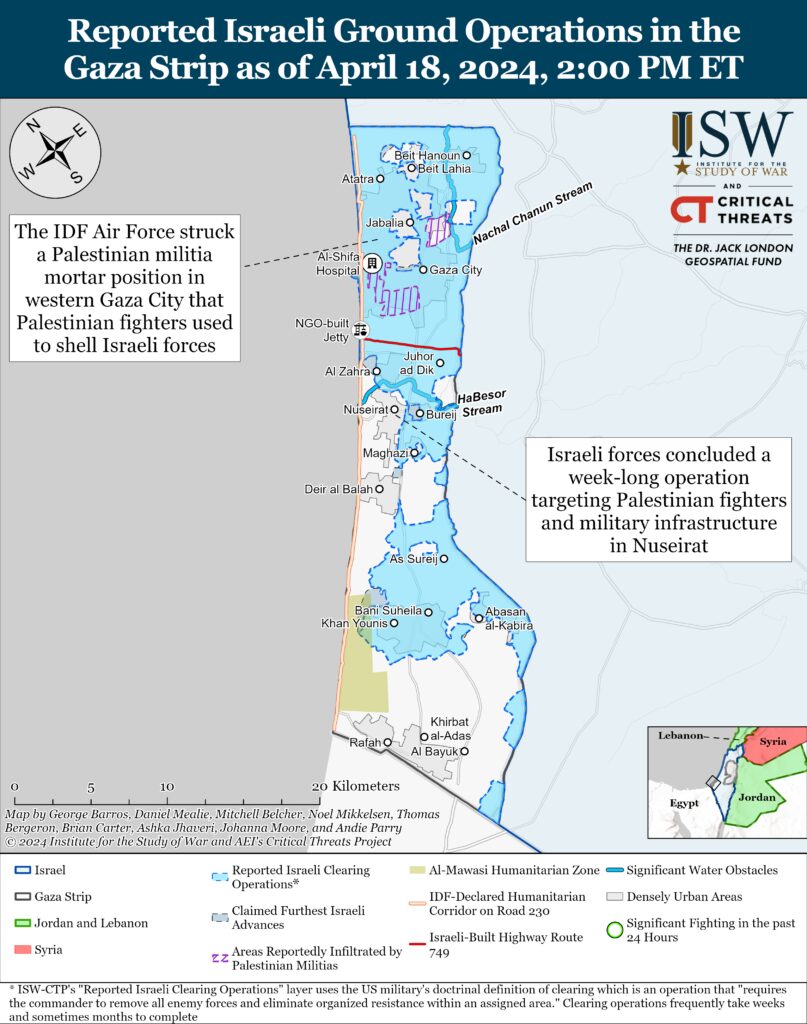
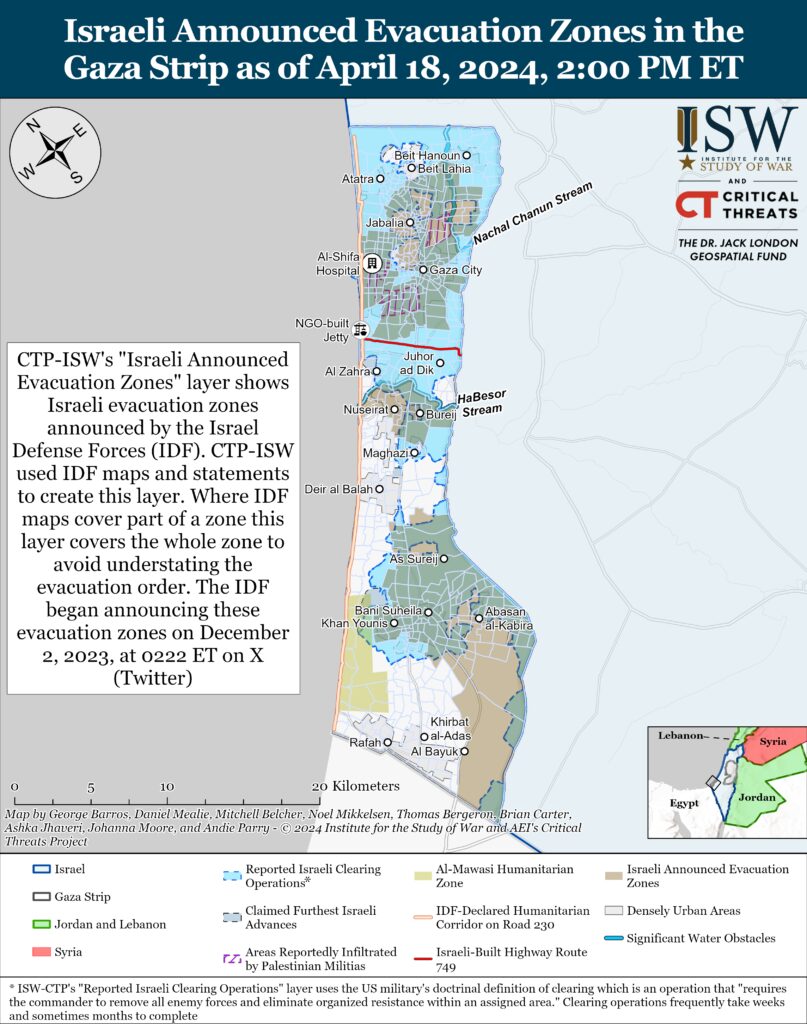
US officials told Axios on April 18 that US President Joe Biden had not approved a military operation into Rafah in return for Israel restraining from conducting a military operation against Iran, contradicting earlier reports.[xxx] An unspecified senior Western diplomat told UK-based and Qatari-privately owned al Araby al Jadeed that Biden had approved the operation in exchange for Israel declining to strike Iran in retaliation for Iran’s April 13 drone and missile attack on Israel.[xxxi]
The US officials separately noted that US and Israeli officials will meet virtually on April 18 to discuss a possible Israeli military operation into Rafah.[xxxii] The officials noted that an Israeli working group presented a “gradual, slow operation in specific neighborhoods of Rafah in order to evacuate” civilians.[xxxiii]
Hamas Deputy Political Bureau head Musa Abu Marzouk said on April 18 that Hamas will not withdraw from ceasefire negotiations or drop its maximalist demands, which include a permanent ceasefire in the Gaza Strip.[xxxiv] Marzouk added that Hamas does not know how many Israeli hostages are dead or alive.[xxxv] Hamas rejected the latest US-proposed ceasefire and hostage-for-prisoner exchange deal on April 13, just hours before the Iranian drone and missile attack on Israel.[xxxvi] Hamas has since demanded new concessions from Israel in its counteroffer, according to one Israeli official.[xxxvii] The official said that Hamas sought to release fewer Israeli hostages in addition to asking for a higher ratio of hostage-for-prisoners and for Israel to release more Palestinian prisoners held under a life sentence.[xxxviii]
The World Food Programme (WFP) delivered aid via the Erez crossing on the northern Gaza Strip border for the first time since the war began.[xxxix] WFP confirmed that three convoys with enough food and wheat flour for nearly 80,000 people crossed into the northern strip on April 18.[xl] The Israeli War Cabinet approved the reopening of its Erez crossing with the northern Gaza Strip on April 5, which has been closed since the beginning of the war.[xli]
PIJ conducted two rocket attacks from the Gaza Strip targeting southern Israel on April 18.[xlii]
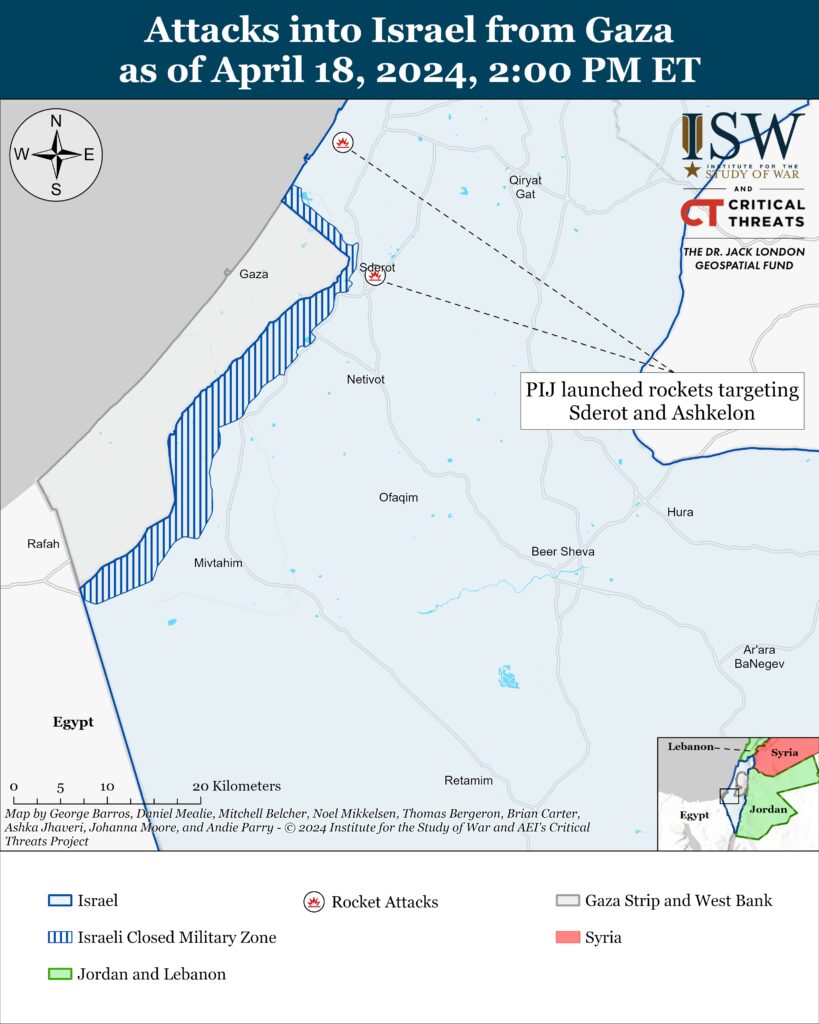
Recorded reports of attacks; CTP-ISW cannot independently verify impact.
West Bank
Axis of Resistance objectives:
Establish the West Bank as a viable front against IsraelIsraeli forces have engaged Palestinian fighters in at least two locations in the West Bank since CTP-ISW’s last data cut off on April 17.[xliii] The al Aqsa Martyrs’ Brigades engaged Israeli forces with small arms and detonated an improvised explosive device targeting an IDF vehicle in the Nour Shams refugee camp in Tulkarm on April 18.[xliv] Palestinian media reported that Lions‘ Den fighters targeted Israeli forces with small arms at an Israeli checkpoint in Nablus on April 17.[xlv] The Lions’ Den—a West Bank militia based in Nablus that has built a large social media following—had not claimed an attack targeting Israeli forces since October 23, 2023 and had been inactive on Telegram.[xlvi] Pro-Hamas media published several references to the Lions‘ Den on April 13 amid reports of Israeli settlers committing acts of violence in at least eight Palestinian towns in the northern West Bank.[xlvii]
Israeli police detained a Palestinian reportedly affiliated with ISIS during an overnight operation near Ramallah. The reportedly ISIS-affiliated Palestinian had planned to carry out an unspecified attack “in the immediate future.”[xlviii] Shin Bet took custody of the suspect.[xlix]
Human Rights Watch (HRW) reported that Israeli settler attacks on Palestinians in the West Bank increased in 2023 to their highest level since the United Nations (UN) began recording data in 2006.[l] The UN documented over 700 Israeli settler attacks on Palestinians in the West Bank between October 7, 2023, and April 3, 2024.[li] HRW reported that the Israeli military did not protect Palestinians from settler violence and on some occasions participated in the attacks.[lii]
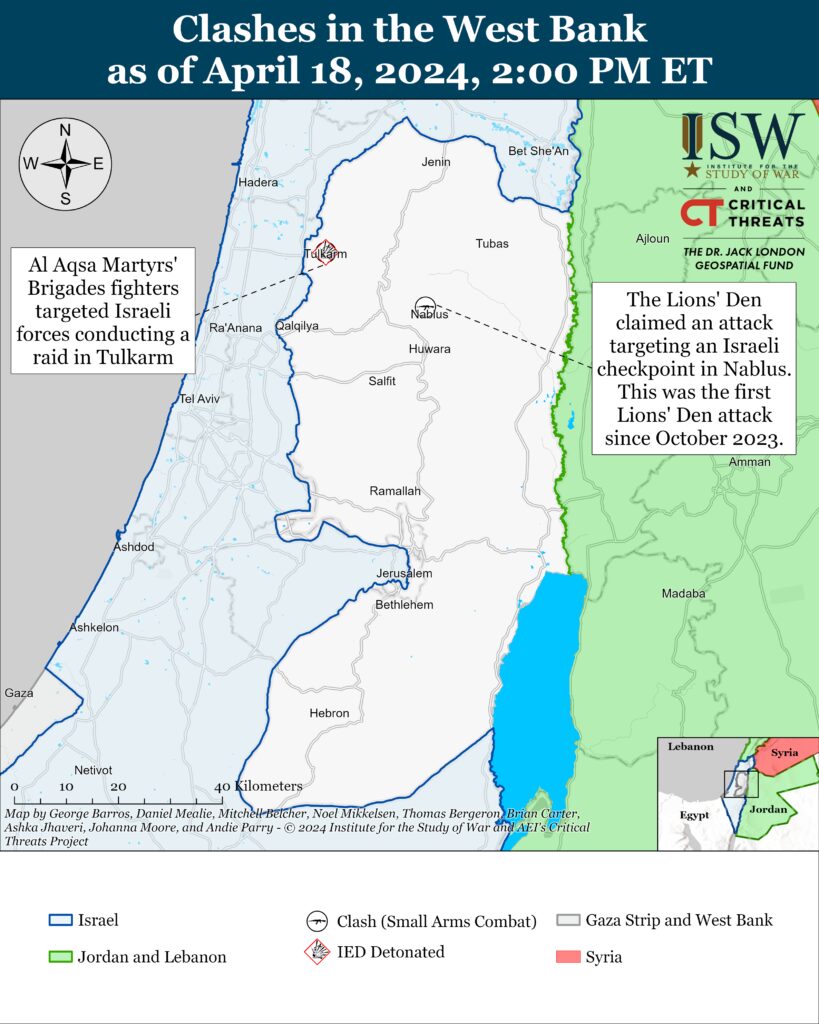
This map is not an exhaustive depiction of clashes and demonstrations in the West Bank.
Southern Lebanon and Golan Heights
Axis of Resistance objectives:
Deter Israel from conducting a ground operation into Lebanon
Prepare for an expanded and protracted conflict with Israel in the near term
Expel the United States from SyriaLebanese Hezbollah has conducted at least nine attacks from southern Lebanon into northern Israel since CTP-ISW’s last data cutoff on April 17.[liii] Hezbollah published a video on April 18 showing Hezbollah fighters launching an anti-tank guided missile on April 17 that destroyed an IDF counter-battery radar on Mount Meron.[liv] The IDF base on Mount Meron hosts air traffic control, radar, surveillance, communication, and jamming facilities.[lv] Counter-battery radars detect incoming indirect fire to ascertain the indirect fire’s point of origin. This information allows friendly forces to then engage the enemy artillery battery. Hezbollah’s first attack targeting Meron on January 6 damaged the bases’ radar domes.[lvi] Hezbollah has attacked Meron seven times in 2024.[lvii] Hezbollah has conducted several attacks targeting Israeli defenses along the northern Israeli border, including air defense sites, likely to degrade Israeli defenses.[lviii]
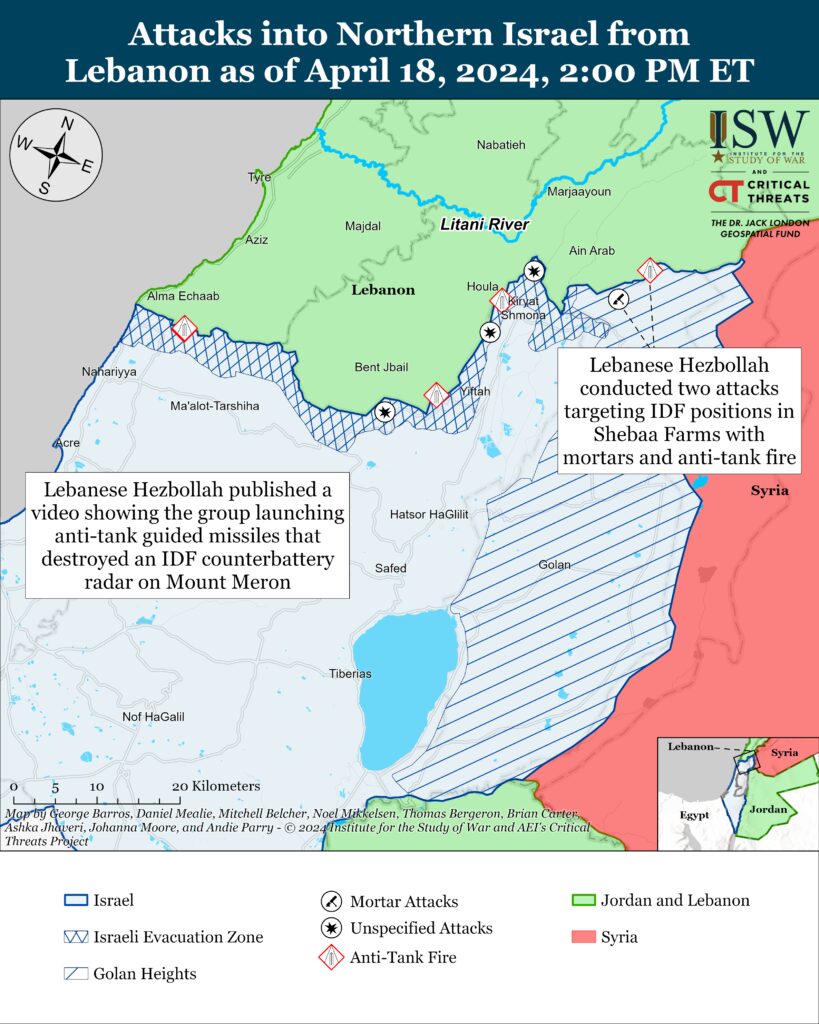
Recorded reports of attacks; CTP-ISW cannot independently verify impact.
Iran and Axis of Resistance
An unnamed senior US official told ABC News on April 17 that Israel is unlikely to retaliate against Iran until after the Passover holiday.[lix] The Jewish holiday Passover concludes at sundown on April 30. The US official added that several senior political and IRGC officials in Iran are in a state of high alert in “safe houses and underground facilities” in preparation for a potential Israeli response.
Bloomberg reported on April 18 that the IRGC intelligence gathering ship, the Behshad, left the Red Sea on April 4 to return to Iran.[lx] The Behshad is expected to reach Iran’s Bandar Abbas port on April 18. The Behshad provides the Houthi movement with real-time intelligence, enabling them to target ships that have gone silent.[lxi] Western and Israeli media speculated that Israel may target the Behshad in its retaliatory strike against Iran’s drone and missile attack against Israel on April 13.[lxii]
Iranian Foreign Affairs Minister Hossein Amir Abdollahian travelled to New York on April 17.[lxiii] Abdollahian is scheduled to attend the United Nations Security Council meeting in New York on the Israel-Hamas war and meet with the United National Secretary General Antonio Guterres.
The United States Treasury Department’s Office of Foreign Assets Control (OFAC) designated sixteen individuals and two entities on April 18 affiliated with Iran’s unmanned aerial vehicle (UAV) production.[lxiv] Some of the sanctioned entities and individuals are involved with producing engines for Iran’s Shahed-131 and Shahed-136 one-way attack drones. OFAC stated that Iran used these UAVs to target major civilian population centers on April 13 in Israel.[lxv] Russia has also used these systems in strikes against Ukrainian civilians and civilian infrastructure.
Two hashtags denouncing regime violence against women were trending on Twitter in Iran on April 18.[lxvi] This came in the context of the Iranian Law Enforcement Command’s decision to resume the enforcement of mandatory veiling throughout Tehran on April 13.[lxvii]
The Iraqi government and private sector signed 14 memoranda of understanding (MOU), primarily in energy and finance, with US companies on April 18.[lxviii] The Iraqi Ministry of Electricity and Oil signed four separate MOUs with the General Electric Company and the Hanwell Company for oil field and “energy sector” development. Unspecified private Iraqi companies signed ten additional energy sector-related MOUs with US energy and engineering companies. The Iraqi National Bank signed a separate MOU with the American International Development Finance Corporation.
Iraqi Prime Minister Mohammed Shia al Sudani visited Washington, DC for a series of meetings with US officials, including US President Joe Biden, to discuss the US-Iraq Strategic Framework Agreement and expanding economic, environmental, and energy cooperation.[lxix]
Sudani also discussed F-16 maintenance and the purchase of spare parts during a meeting with Lockheed Martin on April 18.[lxx] Sudani stated that the maintenance of Iraqi F-16 aircraft is critical for Iraqi national security needs. Lockheed Martin removed F-16 aircraft maintenance crews from Iraq in 2021 due to Iranian-backed militia attacks on US bases, where the crew worked.[lxxi] These are the same Iranian-backed militias that have conducted over 190 attacks targeting US forces in Iraq and Syria between October 2023 and February 2024 as part of a political and military campaign to remove US forces from Iraq.[lxxii]
 Eurasia Press & News
Eurasia Press & News


